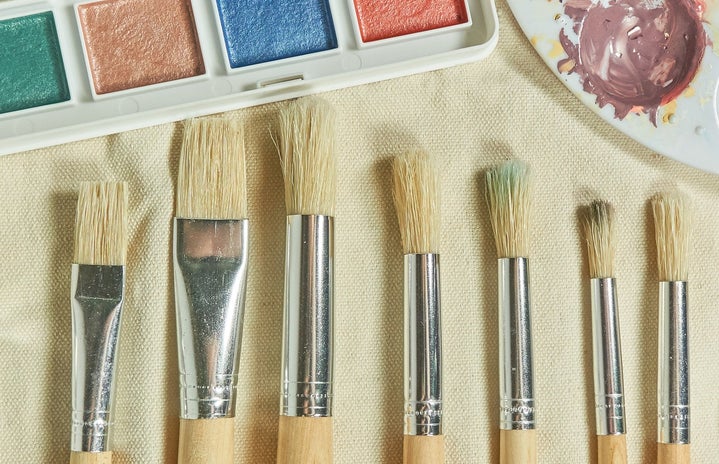For many years, the art industry, like many others, has been a male dominated field. Men were given the spotlight, leaving the women upstaged. There have always been female artists, however, they didn’t get the recognition they deserved. Especially in Brazil, a country that doesn’t make the best effort to support and praise art. Historically, there were very few women artists who managed to become popular and famous. Even nowadays, women still have to fight for their place in this industry.
That’s why it is so important for us to talk about that women. Here are 8 Brazilian artists to be valued and remembered.
- Tarsila do Amaral
-
Born in 1886, Tarsila grew up in her family’s farm, in Capivari, a city in São Paulo. In 1904, she went to Barcelona, Spain, where she made her first painting, called Sagrado Coração de Jesus. Aside from Spain, Tarsila studied art in many other parts of the world. Back in Brazil, Anita Malfatti, her friend and famous painter, introduced her to Modernism, an art movement that took over São Paulo in 1922 and changed the country’s artistic cenario. Tarsila created masterpieces that blended the Brazilian culture with the European style. Together with Oswald de Andrade and Raul Bopp, she created the famous movement called Antropofagia. Tarsila actually married Oswald in 1926, but, three years later, he left her for Pagu, a renowned writer at the time. Her sadness inspired the painting Figura Só, in which the woman resembles a tear. Tarsila do Amaral was one of the most famous Brazilian painters and became known worldwide. Some of her most famous paintings are: Operários, Abaporu, A Negra, Antropofagia and O Autorretrato.
- Abigail de Andrade
-
The painter was born in Vassouras, Rio de Janeiro, in 1864. Unfortunately, we don´t know a lot about this artist. She died in the beginning of her career, in 1890, due to tuberculosis. Nowadays, most of her paintings belong to private collectors. As long as the female role was limited to the domestic sphere, Abigail was seen as na amateur. Becausa of that, shw isn´t mentioned in most art history books. Abigail studied in the Liceu de Artes e Ofícios, only one year after a decree allowed women to attend the school. In 1884, she was awarded at the Exposição Geral, a very big social event during the Second Empire. It was the first time that the jury gave the most renowned prize to a woman. Abigail was considered to be a visionary, her technique was ahead of her time and she resembled the Modernism. She was known for painting routine situations. Her most remarkable paintings are: Um Canto do Meu Ateliê, Estendendo a Roupa, Paisagem, O Cesto de Compras and Hora do Pão.
- Anita Malfatti
-
Born in 1889, in São Paulo, Anita was one of the most important painters of Modernism. Interesting fact: she was born with atrophy in her left arm, a disability she had to deal with her entire career. When she was 13 and feeling lost about what to do with her life, she wanted to have a near-death experience. Anita laid on a train track and watched the train pass above her. After that, she decided she wanted to be a painter. Malfatti studied art in Europe and in the United States. Back in Brazil, she was really focused on Modernism and joined Mario de Andrade, Tarsila do Amaral, Oswald de Andrade and Menotti del Picchia at the Grupo dos Cinco, a group that revolutionized the art industry. During the Modern Art Week, Anita displayed 20 of her paintings. Some of her most outstanding works are: O Homem Amarelo, A Boba, Burrinho Correndo and A Mulher dos Cabelos Verdes.
- Rosina Becker do Valle
-
Rosina was born in Rio de Janeiro, in 1914, and worked as a housewife for a significant part of her life. She started painting for pure pleasure only in 1955. She was a naif painter, a self taught artist. Her first exhibition was in 1963 at Geraldo Esdon de Andrade’s Gallery. Rosina’s paintings have been displayed worldwide, in over 110 museums. Nowadays her paintings compose the collections of museums in Rio de Janeiro, São Paulo, Paris, Nice, Hamburg and Buenos Aires. Rosina’s vision was vibrant, innocent and loyal to the popular ambiences. Since the beginning of her career she was well received by the critics and won many renowned awards. Her most famous paintings are: Floresta, A Hora da Oração, Homenagem a Ogum, Jardim Zoológico and O Circo.
- Tomie Ohtake
-
The artist was born in Kyoto, Japan, in 1913. She came to Brazil in 1936 to visit her brother and couldn’t go back to her homeland because of the Pacific War. For that reason, she stayed in the country and became a Brazilian citizen. Encouraged by the japanese artist Keiya Sugano, Tomie started painting when she was 40 years old. Her career really took off in her fifties, she excelled in both printmaking and painting as well as in sculpturing. Ohtake’s work has been displayed in over 120 international exhibitions, including in Brazil, United States, Italy and Japan. She has received 28 awards. Her sculptures, paintings and many other art works can be found all over the city of São Paulo. Her most acclaimed works are: As Quatro Estações, Paisagem, Monumento Tomie Ohtake and Monumento da Imigração Japonesa.
- Haydéa Santiago
-
Haydéa was a painter from Rio de Janeiro, born in 1896. Her painting style went against the academic conventions, it was very diverse. She used very different genders to compose her works, from dead nature to everyday scenes. Haydéa and her husband, who was also a painter, were very inspired by the impressionist paintings of Eliseu Visconti. She has received awards in both Brazil and France. Her most memorable paintings are: A Corista, Jardim Botânico, Paisagem and Casa Branca.
- Rosana Paulino
-
Born in São Paulo, in 1967, Rosana is a doctor of visual arts by the Escola de Comunicação e Artes da Universidade de São Paulo and a specialist in printmaking by the London Print Studio. Her works are linked to social, ethnic and gender issues. Her main focus is the position of black women in society and the different types of violence suffered by this population, due to racism and the marks left by slavery. Aside from Brazil, her works are also displayed in museums of the United States. Rosana’s most distinguished pieces of art are: Assentamento, Tecelãs, Série Bastidores and Paredes da Memória.
- Sônia Gomes
-
Sônia was born in the city of Caetanópolis, Minas Gerais, in 1948. Daughter of a black woman and a white man, her works of art are influenced by these two cultures. Blending the popular and the erudite, she created sculptures made of fabric. She has won many awards and her art has been displayed in different parts of Brazil, specially in São Paulo and Minas Gerais. Sônia’s most famous works are: Tecendo Amanhã, Oratório and Torção.
These women played an essential role in the Brazilian artistic scenario. Reading about them and valuing their work is a way to make sure they are never forgotten.
————————————————————————
The article above was edited by Helena Leite.
Like this type of article? Check Her Campus Cásper Líbero.



